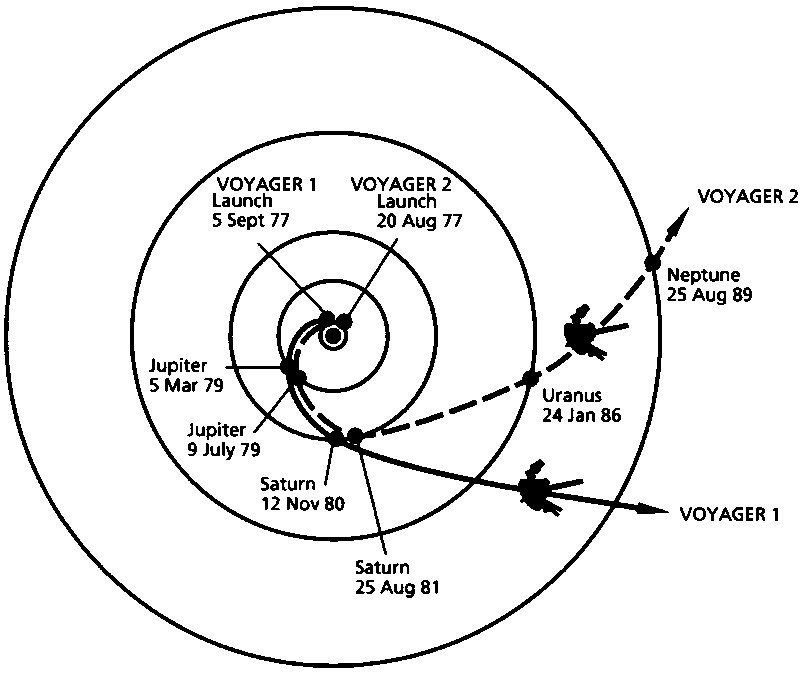
Overhead View of the Journey of the Voyagers (courtesy of NASA)
Historical Overview of the Voyager Spacecraft
The Voyager Space Probes were originally designed as part of a multi-craft program known as the Grand Tour. The basic goal of The Grand Tour was to send multiple probes to throughout the solar system in a grand spirit of exploration. Despite the large dreams of its NASA designers, the Grand Tours soon became a victim of its own grand price tag. Budget cuts forced NASA to eliminate all but two of the planned Grand Tours spacecraft. Once the dust had cleared, what was left of the Grand Tour found itself reorganized as the Voyager Mission.
Voyager 2 was launched from Cape Canaveral, Florida on August 20, 1977. Voyager 1 was launched a few weeks later on September 5, 1977. The basic idea of the Voyager mission that a rare alignment of the outer planets occurring in the late 70s and 80s would allow spacecraft to make a broad survey of the solar system in a short amount of time using minimal amount of fuel (see http://voyager.jpl.nasa.gov/science/planetary.html).

Overhead
View of the Journey of the Voyagers (courtesy of NASA)
Voyager 1 was launched on a faster trajectory and overtook Voyager 2 while the craft were passing through the asteroid field between Mars and Jupiter. In early March 1979, Voyager 1 reached the Jupiter and began taking scans and pictures of the Jovian system. Voyager 2 reached Jupiter four months later and began similar scientific investigations.
Saturn was reached by Voyager 1 on November 12, 1980 and by Voyager 2 on August 25, 1981. After making exhaustive studies of Saturn, it's rings, and it's moons, Voyager began its long trip out of the solar system and into the void of interstellar space.
Five years after its Saturn encounter, Voyager 2 reached Uranus. After taking its normal set of observations, Voyager 2 headed on to Neptune, finally reaching the planet in August of 1989. After cataloging data about the Neptunian System, Voyager 2, like Voyager 1 nine years earlier, began its long journey out into interstellar space (see http://ringmaster.arc.nasa.gov/voyager/mission/mission.html#overview).
In February 1990, shortly after Voyager 2 had finished its survey of Neptune, Voyager 1 turned its cameras back on and took the first, and so far only, photographs of the planets of the Solar System as seen from outside of the Solar System. With the glorious part of their missions complete, both Voyagers set about collecting data on the magnetic and particle conditions in the outer solar system.
[Home]
[Voyager Program History] [Voyager Probe Technology] [Voyager Images] [The Golden Record] [Where Are They Now?] [Bibliography/Links]